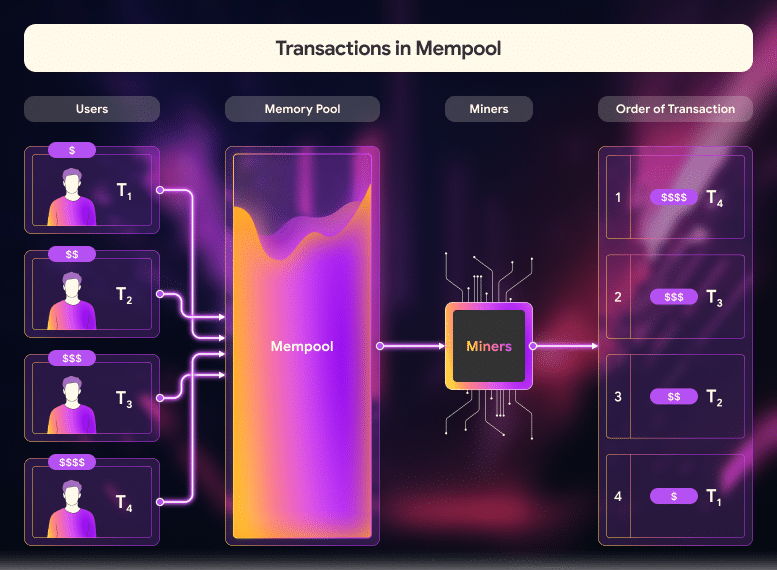What is MEV? Maximal Extractable Value explained

Miners and validators help make the blockchain world go round. They validate network transactions and earn rewards through block rewards and transaction fees.
But did you know that these block producers earn profits beyond the standard block reward?
Maximal Extractable Value (MEV) represents the additional profit that block producers can obtain by reordering pending transactions on the blockchain network. MEV transactions have attracted attention and scrutiny recently.
You may have even heard the news of how an MEV bot has taken thousands from crypto traders.
While maximal extractable value is an offshoot of blockchain decentralization, it also poses potential implications to various stakeholders.
This article seeks to demystify MEV’s role within the blockchain industry by:
- Discussing what is MEV
- Examining how MEV extraction works
- Differentiating Miner Extractable Value vs. Maximal Extractable Value
- Revealing MEV opportunities
Read on and be educated about this new phenomenon.
What is Maximal Extractable Value (MEV) and How Does it Work?
When financial markets began embracing technology, profit fell to players with better technology and faster information. The better the edge, the higher the profits. Even a difference of seconds plays a major advantage.
The best technology is essential to detect profitable transactions; players invest heavily in MEV bots to detect profitable MEV opportunities.
A Brief History of Maximal Extractable Value (MEV)
Miner Extractable Value (the predecessor to maximal extractable value) first gained prominence in 2019. A group of researchers published a paper entitled: Flash Boys 2.0: Frontrunning, Transaction Reordering, and Consensus Instability in Decentralized Exchanges.
The paper detailed how MEV bots (autonomous programs) exploited economic inefficiencies in Decentralized Exchanges (DEXes). These attacks were contrary to blockchain’s promise of a fair and transparent ecosystem.
Where Does MEV Come From?
Blockchain is a decentralized and distributed digital ledger that securely records and verifies transactions across a network of computers. A blockchain network comprises a series of blocks that hold validated and pending transactions from users, thus the term blockchain.
Unconfirmed transactions wait in the memory pool (or mempool), a staging room for transactions not yet placed in a block. As blockchains are publicly available, block producers can see and choose which transactions in the mempool to process first.
Block producers can influence the sequence of user transactions to include in a block. Being motivated by profit, they will often select the transactions with the highest gas price (transaction fees).
Take the Ethereum blockchain network as an example: a typical cryptocurrency transfer can cost $1 to $2 in gas fees. A sender may opt to increase the gas fee to $10, which validators will surely prioritize.
The MEV extraction takes place during block production. Validators, in their role as block producers, have the discretion to select and organize transactions. By doing so strategically, they can gain additional value beyond traditional block rewards and transaction fees.
What is MEV in Staking?
The Bitcoin network’s consensus mechanism relies on miners, thus the term miner extractable value. Ethereum previously relied on mining to validate transactions but has since shifted to staking. Stakers validate transactions by locking cryptocurrency into the network.
The term Maximal Extractable Value evolved from Miner Extractable Value when many blockchain networks such as Ethereum, moved away from a Proof-of-Work (PoW) consensus to a Proof-of-Stake (PoS) consensus.
Maximal Extractable Value also encompasses the broader concept of potential value extraction within the entire blockchain ecosystem.
Whereas Bitcoin transactions relate mostly to payments and transfers, newer blockchains support various use cases:
- Non-Fungible Token (NFT) minting
- Cryptocurrency lending
- Decentralized exchanges
These new use cases, often facilitated by smart contracts (self-executing code), make up the Decentralized Finance (DeFi) industry. DeFi transactions present more opportunities to extract MEV.
What is an MEV Searcher?
While block producers should be capitalizing on lucrative MEV opportunities, in practice MEV searchers stand to gain the most.
MEV searchers are participants within the blockchain ecosystem that actively detect profitable MEV opportunities. MEV searchers often employ sophisticated algorithms and tools to analyze the pending transactions in the mempool and identify scenarios where they can gain a financial advantage.
MEV searchers program MEV bots to execute and capture profit across the crypto landscape.
Once a searcher finds an MEV opportunity, the participant will submit the same transaction with higher gas fees to be prioritized by block producers.
MEV searchers aim to capitalize on the time-sensitive nature of transaction processing in decentralized networks, such as Ethereum, to front-run trades, perform arbitrage, or engage in other activities that exploit the sequential execution of transactions.
How do Validators and Stakers Profit from MEV?
A staker, whether through third-party staking or as a solo staker, can earn extra income through MEV. As validators have control over block production, searchers work with these block producers to ensure their transactions are prioritized.
On Ethereum, Flashbots has created an auction tool called “mev-boost” which allows searchers and validators to communicate with one another. Validators process searchers’ transactions and earn extra profit from these.
Validators need to have good standing as those validators will more likely get chosen by the network to propose blocks.
Stake.fish, a staking-as-a-service (Saas) provider, gives its stakers an extra 0.75% APR in addition to the regular 3.04% APR of Ethereum staking.
MEV Examples
Whether it’s by exploiting time-sensitive information or disrupting transactions, players have found ways to detect MEV opportunities. The blockchain industry’s growing use cases present a lucrative environment for MEV profits.
Sandwich Attacks
Sandwich attacks involve strategically placing a high-value transaction between two lower-value transactions. This tactic aims to exploit the market impact of the high-value trade, allowing the attacker to capitalize on price discrepancies.
A sandwich attack typically occurs on trades involving Decentralized Exchanges (DEX). A trader is negatively affected by the price or cryptocurrency received, and the attacker benefits from the price difference.
Here’s a high-level example of a sandwich attack: a trader makes an order to buy $10,000 of Solana on Jupiter, a decentralized exchange. The transaction lines up in the mempool.
- An MEV bot executes an order to buy Solana, raising the token price.
- The trader’s buy order gets done at a higher token price.
- The MEV bot sells the token, profiting from the price difference.
The trader ends up paying higher token prices due to slippage, the price difference between their order price and the final executed price.
DEX functionality allows users to set a slippage percentage. Traders may use high slippage settings to execute highly volatile trades or those with illiquid markets. Unfortunately, these are susceptible to MEV bot attacks.
In two months of 2024, a Solana MEV bot called “arsc” made $30 Million from users.
Front-Running
A front-running attack constitutes market manipulation in which an MEV bot exploits advanced knowledge of pending transactions to gain an unfair advantage. This is relevant in decentralized networks, where transactions are visible to the public before they are confirmed.
Front-running happens quite often in the non-fungible token (NFT) space with MEV bots designed to find profitable transactions and execute them instantly.
Take, for example, Bored Ape Yacht Club (BAYC), a highly popular NFT listed on the Opensea marketplace.
- Given that the floor price (bottom price) of 1 BAYC NFT is 25 ETH.
- A holder wants to list their NFT for sale.
- Instead of a listing price of 25 ETH, the holder makes an error and executes at 2.5 ETH.
- Before the holder can cancel the transaction, an MEV bot successfully conducts a buy order.
This similar trade took place in December 2021. A BAYC was sold for $3,000 instead of $300,000, representing a 90% loss. The owner had committed a typing error upon listing the NFT. Before the owner could cancel the listing, an MEV bot had already bought it.
This practice raises concerns about fairness, trust, and the integrity of financial transactions within decentralized systems.
Users can only do so much when paired against an MEV bot.
Preventing front-running attacks is an ongoing challenge for blockchain developers and security experts.
Pros and Cons of MEV
MEV exists as a byproduct of blockchain technology. One can consider it as a sub-industry and innovation within the industry. Others may consider MEV as a menace to normal market participants.
How MEV is used and its impact on the ecosystem can be evaluated in different ways:
Potential Benefits of MEV Extraction
- Profit Incentive for Block Producers: MEV provides an additional incentive for miners and validators, potentially enhancing their revenue beyond traditional block rewards and transaction fees.
- Market Efficiency: In some cases, MEV activities can contribute to market efficiency by allowing participants to respond quickly to market movements or arbitrage opportunities. For example, if the market price on one DEX varies widely from another, an MEV arbitrage transaction will help address this.
- High Transaction Priority: A user can increase the gas fees (transaction fee) of his or her transaction to ensure it is executed. Users are willing to pay high gas fees to participate in highly anticipated market opportunities such as NFT minting and token presales.
Concerns and Drawbacks of MEV Extraction
- Unfair Advantage: MEV strategies, such as front-running, can provide certain actors with an unfair advantage, compromising the principle of fair and equal access to market opportunities.
- Market Manipulation: Certain MEV tactics such as sandwich attacks can be seen as a form of market manipulation, potentially distorting natural market forces and causing undue losses to regular traders.
- Erosion of Trust: MEV opportunities can abuse and erode trust in the decentralized ecosystem, potentially dissuading users from participating in the market even further.
MEV Revenue Generated in the Ethereum Network
Whether fair or unfair, the MEV industry has been growing.
A 2023 report by Galaxy Research revealed that MEV on Ethereum earned $133 Million for the entire 2022. By 2023, this value has grown to $600 Million.
MEV has been extremely profitable, with MEV revenue growing year by year. However, with the polarizing nature of MEV, certain industries have also sprung up to bring light to MEV.
Flashbots is a research and development organization formed to mitigate the negative consequences of when MEV occurs. Their focus is to bring light to MEV opportunities and enable a sustainable MEV ecosystem.
Is MEV Good or Bad?
Whether MEV is perceived as good or bad often depends on one’s perspective—some see it as an inherent part of market dynamics. In contrast, others view it as a potential source of manipulation and unfair practices.
The blockchain community needs to continue addressing MEV-related challenges and work toward solutions that maintain fairness, security, and the overall integrity of decentralized systems.
Editor’s Note: This article was originally published in February 2024 but has been updated with new information
The content of solostakers.com is for informational purposes only and should not be considered financial advice. It represents the personal views and opinions of the author(s) and is not endorsed by any financial institution or regulatory body. Cryptocurrency and staking investments carry inherent risks and readers should conduct their own research and consult with a financial professional before making any investment decisions. The owner and author(s) of solostakers.com will not be liable for any losses, damages, or consequences arising from the use of the information on this site. By accessing solostakers.com, you agree to bear full responsibility for your investment decisions.
June 20, 2024
October 23, 2024








